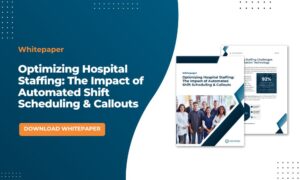Blog
Hidden Costs: How Hospital Understaffing Drives Up Expenses and Solutions to Prevent it
Wednesday August 21, 2024
Hospital understaffing remains a critical issue, not just in terms of patient care but also in the financial repercussions that come with it. Understaffing can lead to severe penalties, increased insurance costs, and, ultimately, poorer patient outcomes. To address this problem, healthcare leaders must explore innovative tools and strategies to maintain optimal staffing levels. This blog will explore the financial implications of understaffing, particularly the additional insurance costs, and discuss tools that can help hospitals avoid these challenges.
The Financial Repercussions of Understaffing: A Case Study
The case of Mount Sinai Health System serves as a stark reminder of the financial consequences of understaffing. In a high-profile case, Mount Sinai was fined $2 million for understaffing nurses. The fines were levied after it was found that the health system failed to meet the minimum staffing requirements, compromising patient care and safety. The penalty imposed on Mount Sinai is a significant financial burden, but it is only the tip of the iceberg when it comes to the financial implications of understaffing.
Fines for understaffing are becoming increasingly common as regulatory bodies crack down on healthcare organizations that fail to provide adequate staffing levels. Additional insurance costs often accompany these fines, as insurers view understaffing as a risk factor that can lead to higher claims. Increased insurance premiums can also accompany this as insurers seek to mitigate their risk exposure.
The Role of Insurance in Healthcare Staffing
Insurance is critical in the healthcare industry, providing financial protection for hospitals and healthcare providers. However, insurance companies also assess the risk of insuring healthcare organizations, and staffing levels are a key factor in this assessment. When hospitals are understaffed, the risk of adverse events, such as medical errors, patient injuries, and even lawsuits, increases. This elevated risk translates into higher insurance premiums. In addition to higher premiums, understaffed hospitals may also face difficulties obtaining insurance coverage. Insurers may be reluctant to provide coverage to organizations that do not meet minimum staffing requirements, as the potential for costly claims is too high. This can leave hospitals vulnerable to financial losses, as they may be forced to self-insure or pay exorbitant premiums for limited coverage.
Consequences of Understaffing on HCAHPS Scores
Understaffing in hospitals can significantly impact HCAHPS scores, which are crucial for measuring patients’ perceptions of their hospital experience. When hospitals are understaffed, critical areas such as surgery scheduling, ER wait times, and bedside care can deteriorate, leading to negative patient experiences. These perceptions are captured in lower HCAHPS scores, which have far-reaching consequences. Not only can low scores damage a hospital’s reputation, but they also directly impact financial outcomes. In 2019, for example, $1.9 billion in value-based payments was allocated to hospitals based on their HCAHPS scores across domains like clinical outcomes, safety, and patient engagement. Hospitals with the highest scores received the most financial support, while those with exceptionally low scores faced financial penalties, reducing the amount of Medicare funding they received. Thus, understaffing can create a vicious cycle, where poor patient experiences lead to lower HCAHPS scores, which in turn result in financial losses and further challenges in attracting and retaining skilled staff.
The Impact of Understaffing on Patient Outcomes
The financial implications of understaffing are significant but only part of the story. Understaffing also directly impacts patient outcomes, which can further exacerbate the financial challenges hospitals face. When hospitals are understaffed, nurses and other healthcare providers are stretched thin, leading to increased workloads and burnout. This can result in a higher incidence of medical errors, longer patient wait times, and reduced patient satisfaction.
In a study conducted by a Penn Nursing CHOPR team, it was found that in hospitals with high nurse-to-patient ratios, each additional patient per nurse was associated with a 7% increase in the likelihood of dying within 30 days of admission and a 7% increase in the odds of failure-to-rescue (or the failure to respond effectively to post-surgical complications). Additionally, each additional patient per nurse was associated with a 23% increase in the odds of nurse burnout and a 15% increase in the odds of nurse job dissatisfaction.
Poor patient outcomes can lead to increased costs for hospitals in several ways:
- Hospitals may face penalties from Medicare and other payers if they fail to meet quality benchmarks.
- Hospitals with poor patient outcomes may see a decrease in patient volume as patients choose to seek care elsewhere.
- Hospitals with high rates of medical errors and adverse events may face lawsuits, which can
Tools to Ensure Optimal Staffing Levels
Given the financial and clinical risks associated with understaffing, healthcare leaders must implement tools and strategies to ensure optimal staffing levels. Several innovative solutions are available to help hospitals maintain adequate staffing, reduce insurance costs, and improve patient outcomes.
Automated Shift Filling Solutions
One of the most effective ways to address understaffing is through automated shift-filling solutions. These tools, such as the ones offered by Vocantas, streamline the filling of open shifts, ensuring that staffing levels are maintained even in the face of unexpected absences or high demand. Automated shift-filling solutions can quickly identify vacant or open shifts and automatically send out shift callouts to eligible staff, filling shifts 17 times faster and reducing the manual effort required to fill open shifts. In addition to improving staffing levels, automated shift filing solutions can enhance employee satisfaction by providing greater flexibility and control over their schedules. This can lead to increased retention and reduced turnover, reducing understaffing risk.
To learn more, download the Whitepaper: Optimizing Hospital Staffing: The Impact of Automated Shift Scheduling & Callouts
Real-Time Staffing Analytics
Another valuable tool for healthcare leaders is real-time staffing analytics. These tools provide insights into staffing levels, patient acuity, and workload distribution, allowing hospitals to make data-driven decisions about staffing needs. Real-time staffing analytics can help identify trends and patterns in staffing, enabling hospitals to address potential issues before they lead to understaffing proactively.
By leveraging real-time data, hospitals can ensure that they have the right number of staff members with the appropriate skills to meet patient needs. This can lead to improved patient outcomes and reduced insurance costs, as insurers are more likely to offer favorable rates to hospitals that demonstrate a commitment to maintaining optimal staffing levels.
Staffing Predictive Modeling
Predictive modeling is another powerful tool that can help hospitals address understaffing. By analyzing historical data and identifying patterns, predictive models can forecast future staffing needs based on factors such as patient volume, seasonal trends, and staff availability. This allows hospitals to plan ahead and ensure that they have the necessary staff in place to meet anticipated demand.
Predictive modeling can also help hospitals identify potential staffing gaps and take proactive measures to address them. For example, if a predictive model indicates that a hospital is likely to experience a staffing shortage during a particular time period, the hospital can take steps to recruit additional staff, adjust schedules, or implement other strategies to ensure that staffing levels are maintained.
Attendance Tracking Solutions
One often overlooked but critical component of ensuring optimal staffing levels is the ability to effectively track staff absences. Absenteeism can quickly lead to understaffing if not managed properly. A robust attendance tracking solution, such as the proactive one provided by Vocantas, can be instrumental in addressing this challenge, preventing understaffing before it occurs.
Vocantas Attendance Tracking is designed to seamlessly integrate with a hospital’s workforce management system, offering real-time visibility into staff attendance. The solutions enable employees to report shift absences and lateness efficiently through a standardized call or text. The reported absences are received in real-time, the Schedulers are updated, and managers receive communications and take quick action. All absence logs are tracked in reports in real-time and can be used to audit attendance trends for future planning. Moreover, hospitals can mitigate the risks associated with increased insurance costs by reducing understaffing through effective attendance tracking. Insurers will likely view hospitals with robust attendance management processes more favorably, potentially leading to lower premiums and better coverage terms.
Conclusion
Hospital understaffing is a critical issue with significant financial and clinical consequences. The additional insurance costs associated with understaffing and the potential for fines and penalties make it essential for healthcare leaders to prioritize staffing levels. Hospitals can maintain optimal staffing levels, reduce insurance costs, and improve patient outcomes by leveraging innovative tools such as automated shift-filling solutions, real-time staffing analytics, and attendance-tracking solutions.
The case of Mount Sinai Health System serves as a cautionary tale for healthcare organizations, highlighting the need for proactive measures to address understaffing. By taking a comprehensive approach to staffing, hospitals can protect themselves from financial losses, enhance the quality of care they provide, and ultimately ensure better outcomes for their patients.
Stay Connected!
Subscribe to our newsletter and receive all our news and updates.
Blog
Check out our
latest Blog Posts
Cutting-edge technologies, industry trends and best
practices workforce management.

Wednesday January 29, 2025
Optimizing Workforce Efficiency with Integrated Manufacturing Scheduling Software
The manufacturing industry operates on precision and efficiency. From raw material sourcing to final product assembly, every second counts. Yet,….

Wednesday January 15, 2025
Top 5 Nursing Home Software Solutions to Invest in for Efficient Operations
As staffing shortages and external factors continue to impact the healthcare industry, nursing homes face increasing pressure to provide high-quality….

Thursday December 19, 2024
Absence Management Guide: Tools to Maximize Workplace Efficiency
Managing employee absences effectively is a cornerstone of organizational success. A well-implemented absence management system not only ensures accurate payroll….





